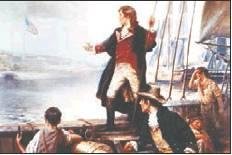Our anthem’s birth
the editor talks with you
Much American history concentrates on major wars and skips over the War of 1812 and the Battle of Fort McHenry. That’s a shame as it was …
This item is available in full to subscribers.
Subscribe to continue reading. Already a subscriber? Sign in
Get 50% of all subscriptions for a limited time. Subscribe today.
Please log in to continueNeed an account?
|
Our anthem’s birth
the editor talks with you
Much American history concentrates on major wars and skips over the War of 1812 and the Battle of Fort McHenry. That’s a shame as it was Britain’s final attempt to undo the outcome of the American Revolution and their defeat by French and American forces at Yorktown. One of the decisive battles of that war was fought at Baltimore in September of 1814, 205 years ago this month. The battle ultimately gave us our national anthem, The Star-Spangled Banner. The cost was dear to the British. They lost 330 men. Some were killed, wounded or captured. We had 4 killed and 24 wounded.
Early Sept. 13, the British commander began moving his fleet toward the Baltimore harbor defenses at Fort McHenry while his infantry advanced towards the city. Shallow waters prevented heavier British ships from entry. A British force of bomb ketches, small warships, and a rocket vessel opened fire, striking Fort McHenry with heavy mortar shells and rockets. The advancing troops believed they had defeated the city’s defenders, but were stunned to find 12,000 Americans dug in. British Admiral George Cockburn, thinking the fort badly damaged, moved closer to increase the effectiveness of his fire. As the ships closed, they came under intense fire and had to draw back.
After dark, the British tried to move around the fort with 1,200 men in small boats. Thinking they were safe, they fired signal rockets giving away their position. As a result, they quickly came under an intense crossfire, taking heavy losses. By dawn, with the rain subsiding, the British had fired between 1,500 and 1,800 rounds at the fort with little impact. The greatest moment of danger had come when a shell struck the fort’s unprotected powder magazine but had failed to explode. Realizing the potential for disaster, the fort’s gunpowder had been moved. As the sun rose, the fort raised seamstress Mary Pickersgill’s 42 by 30 foot flag. Seeing the flag after their futile bombardment, the British were convinced that the harbor could not be breached.
The battle inspired Francis Scott Key to write The Star-Spangled Banner. Key had gone to the British prison ship to negotiate the release of Dr. William Beanes. Moved to write during the fort’s heroic defense, he composed the words to an old drinking song, To Anacreon in Heaven. It was initially published after the battle as the Defense of Fort McHenry. It became known as The Star-Spangled Banner and became our national anthem in 1931. All of us know the words, but just reading them again is inspiring. Oh, say, can you see, by the dawn’s early light, what so proudly we hail’d at the twilight’s last gleaming? Whose broad stripes and bright stars, thro’ the perilous fight, o’er the ramparts we watch’d, were so gallantly streaming? And the rockets’ red glare, the bombs bursting in air, gave proof thro’ the night that our flag was still there. O say, does that star-spangled banner yet wave o’er the land of the free and the home of the brave?
Like what you just read?
Inspire yourself or a loved one with a personally-autographed copy of Jerry Bellune’s “Your Life’s Great Purpose.” It lays out a road map for the kind of life God intends for you. And it’s only $20. Call 359-7633.
Other items that may interest you










Comments
No comments on this item Please log in to comment by clicking here